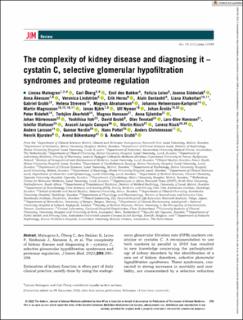| dc.contributor.author | Malmgren, Linnea | |
| dc.contributor.author | Öberg, Carl | |
| dc.contributor.author | den Bakker, Emil | |
| dc.contributor.author | Leion, Felicia | |
| dc.contributor.author | Siódmiak, Joanna | |
| dc.contributor.author | Åkesson, Anna | |
| dc.contributor.author | Lindström, Veronica | |
| dc.contributor.author | Herou, Erik | |
| dc.contributor.author | Dardashti, Alain | |
| dc.contributor.author | Xhakollari, Liana | |
| dc.contributor.author | Grubb, Gabriel | |
| dc.contributor.author | Strevens, Helena | |
| dc.contributor.author | Abrahamson, Magnus | |
| dc.contributor.author | Helmersson-Karlqvist, Johanna | |
| dc.contributor.author | Magnusson, Martin | |
| dc.contributor.author | Björk, Jonas | |
| dc.contributor.author | Nyman, Ulf | |
| dc.contributor.author | Ärnlöv, Johan | |
| dc.contributor.author | Ridefeldt, Peter | |
| dc.contributor.author | Åkerfeldt, Torbjörn | |
| dc.contributor.author | Hansson, Magnus | |
| dc.contributor.author | Sjöström, Anna | |
| dc.contributor.author | Mårtensson, Johan | |
| dc.contributor.author | Itoh, Yoshihisa | |
| dc.contributor.author | Grubb, David | |
| dc.contributor.author | Tenstad, Olav | |
| dc.contributor.author | Hansson, Lars-Olov | |
| dc.contributor.author | Olafsson, Isleifur | |
| dc.contributor.author | Campos, Araceli Jarquin | |
| dc.contributor.author | Risch, Martin | |
| dc.contributor.author | Risch, Lorenz | |
| dc.contributor.author | Larsson, Anders | |
| dc.contributor.author | Nordin, Gunnar | |
| dc.contributor.author | Pottel, Hans | |
| dc.contributor.author | Christensson, Anders | |
| dc.contributor.author | Bjursten, Henrik | |
| dc.contributor.author | Bökenkamp, Arend | |
| dc.contributor.author | Grubb, Anders | |
| dc.date.accessioned | 2023-02-28T15:00:48Z | |
| dc.date.available | 2023-02-28T15:00:48Z | |
| dc.date.created | 2023-01-03T13:31:28Z | |
| dc.date.issued | 2022 | |
| dc.identifier.issn | 0954-6820 | |
| dc.identifier.uri | https://hdl.handle.net/11250/3054759 | |
| dc.description.abstract | Estimation of kidney function is often part of daily clinical practice, mostly done by using the endogenous glomerular filtration rate (GFR)-markers creatinine or cystatin C. A recommendation to use both markers in parallel in 2010 has resulted in new knowledge concerning the pathophysiology of kidney disorders by the identification of a new set of kidney disorders, selective glomerular hypofiltration syndromes. These syndromes, connected to strong increases in mortality and morbidity, are characterized by a selective reduction in the glomerular filtration of 5–30 kDa molecules, such as cystatin C, compared to the filtration of small molecules <1 kDa dominating the glomerular filtrate, for example water, urea and creatinine. At least two types of such disorders, shrunken or elongated pore syndrome, are possible according to the pore model for glomerular filtration. Selective glomerular hypofiltration syndromes are prevalent in investigated populations, and patients with these syndromes often display normal measured GFR or creatinine-based GFR-estimates. The syndromes are characterized by proteomic changes promoting the development of atherosclerosis, indicating antibodies and specific receptor-blocking substances as possible new treatment modalities. Presently, the KDIGO guidelines for diagnosing kidney disorders do not recommend cystatin C as a general marker of kidney function and will therefore not allow the identification of a considerable number of patients with selective glomerular hypofiltration syndromes. Furthermore, as cystatin C is uninfluenced by muscle mass, diet or variations in tubular secretion and cystatin C-based GFR-estimation equations do not require controversial race or sex terms, it is obvious that cystatin C should be a part of future KDIGO guidelines. | en_US |
| dc.language.iso | eng | en_US |
| dc.publisher | Wiley | en_US |
| dc.rights | Navngivelse-Ikkekommersiell 4.0 Internasjonal | * |
| dc.rights.uri | http://creativecommons.org/licenses/by-nc/4.0/deed.no | * |
| dc.title | The complexity of kidney disease and diagnosing it – cystatin C, selective glomerular hypofiltration syndromes and proteome regulation | en_US |
| dc.type | Journal article | en_US |
| dc.type | Peer reviewed | en_US |
| dc.description.version | publishedVersion | en_US |
| dc.rights.holder | Copyright 2022 The Author(s) | en_US |
| cristin.ispublished | true | |
| cristin.fulltext | original | |
| cristin.qualitycode | 2 | |
| dc.identifier.doi | 10.1111/joim.13589 | |
| dc.identifier.cristin | 2099689 | |
| dc.source.journal | Journal of Internal Medicine | en_US |
| dc.source.pagenumber | 293-308 | en_US |
| dc.identifier.citation | Journal of Internal Medicine. 2022, 293 (3), 293-308. | en_US |
| dc.source.volume | 293 | en_US |
| dc.source.issue | 3 | en_US |

